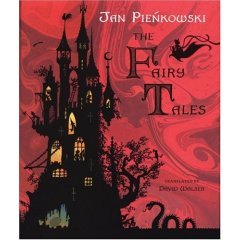
Forgotten Book of the Week: The Duchess Bakes a Cake
by Virginia Kahl
Scribners & Sons, 1955
Reissued: Purple House Press, 1983
Baking mishaps seem like a recurring motif in children's literature, from "The Gingerbread Man" to "In the Night Kitchen" and onwards, and yet I don't ever seem to tire of it. I'm betting that a lot of kids don't, either. Which, of course, brings me to the delightful dottiness of Virginia Kahl's The Duchess Bakes a Cake. Here's how the book begins:
A long time ago there lived over the watersWhenever I read this intro, I can't help but be reminded of that other book from the 1950s about twelve little girls in two straight lines. But the similarity ends there. Kahl's story about the Duke and Duchess' prodigious family is set in a world given over to silliness, where adults and children alike play the fool. "They couldn't think often, and hadn't thought much."
A Duchess, A Duke, and their family of daughters --
Madeleine, Gwendolyn, Jane and Clothilde,
Caroline, Genevive, Maude and Mathilde,
Willibald, Guinevere, Joan and Brunhilde,
And the youngest of all was the baby, Gunhilde.
The story begins with the angular, Olive-Oyl-Goes-Medieval-style Duchess, who usually likes to spend her time "reading and writing," growing bored and deciding to bake a cake. Being a noblewoman, she hasn't the faintest idea of how to go about making "a lovely light luscious delectable cake," but simply adds ingredients helter-skelter into the bowl:
In went the almonds, the raisins, the suet;Predictibly, the cake rises to immense proportions, trapping the Duchess in the air on an enormous mound of dough. "I fear an improper proportion of leaven / Is taking my dear Duchess right up to Heaven," cries the Duke. How will she get back down? The castle folk all have ludicrously impractical ideas, but, of course, it is the Duchess's own children who create the best solution.
She added some vinegar and dropped in the cruet.
She added the yeast, six times for good measure.
(A light fluffy cake is really a pleasure.)
Kahl was a librarian, and you can tell: her rhyming text and clever rhymes beg for this book to be read out loud. As for her three-color illustrations, they seem like a cross between Lois Lenski and James Thurber. Thick lines delineate the characters and scenery, and Kahl uses little details to give the characters charm. The palace cook, with his long, upturned nose and spoon on his hip, looks like he fell straight out of a vintage New Yorker cartoon. The thirteen daughters, meanwhile, are simply adorable with their little red caps, white dresses and pudgy green arms. If I had read this book as a child, I would have loved to have a set of dolls that looked just like them.
Kahl wrote several books about the Duke and Duchess' family; this is the most well-known and is the only one that has ever been reissued. This loopy castle community is addictive; if The Duchess Bakes a Cake falls into the hands of any young readers you know, you may find yourself scouring used book markets to collect the whole set.

